Asklepios
was the Greek god of medicine and healing. Some say
he was a real physician, a mortal who became a god.
Among his healing abilities, Asklepios could revive
the dead with the blood of Medusa. Yet as Greek myths
and tragedies go, Hades (the god of the underworld)
feared this intervention would deny his existence.
So Hades confronted Zeus, complaining that no mortal
or god should have this power. Persuaded by the argument,
Zeus “smoked” Asklepios with a thunderbolt.
Gone, but not forgotten.
The centaur Charon raised Asklepios, the son of Apollo.
The centaur taught his adopted son the healing arts.
The symbol of Asklepios’ healing center was a rod
with an entwined snake. This symbol gave rise to the
modern medical profession’s symbol – the
caduceus.
Though the Canyonlands Region is far from the temples
of ancient Greece, there is a connection between place
and person.
The great Swedish naturalist Carl von Linnaeus (1707-1778)
honored this ancient healer by naming a genus of plants,
Asclepias, after him. Several members of the genus are
common throughout southern Utah and may be found blooming
in summer.
Showy milkweed (Asclepias speciosa) is a widely distributed
perennial that may grow up to four feet tall. The large,
opposite leaves are oval in outline and may be six to
eight inches long. The pinkish-white flowers grow in
a cluster and attract a variety of large butterflies
and insects as pollinators. Though Native Americans consumed
the young buds, shoots and seedpods, this milkweed is
best known for its relationship with the monarch butterfly.
The female butterfly lays her eggs on the undersides
of milkweed leaves. The developing caterpillars consume
the leaves, but are not affected by the toxic glycosides
produced by the plant to deter herbivores. Instead, the
caterpillars concentrate these compounds within their
bodies, and this, along with their coloration pattern,
make them undesirable as prey. As the caterpillars molt
into adult butterflies, the compounds continue to protect
the adult. Predators soon learn that ingesting these
orange and black-veined insects produce gastric distress
and severe vomiting.
Showy milkweed has qualities, as well. The seed down
was collected in WWII by schoolchildren and sent to processing
factories. The lightweight down was inserted into life
jackets for buoyancy or flight suits for insulation.
Butterfly-weed or pleurisy-root (Asclepias tuberosa)
has been used in the treatment of bronchial infections,
pleurisy and rheumatism for hundreds of years. The roots
of this plant were ground into a powder and either brewed
as a tea or made into poultices for open wounds and sores.
In 1751 John Bartram (1699-1777), the preeminent American
botanist and plant explorer, wrote “the root must
be powdered and given in a spoonful of rum, or rather
as the Indians give it, bruise the root and boil it in
water and drink the decoction….”
Consumption of the tea increases bronchial dilation and
drainage of the lymph system.
Even the orangish flowers were harvested as a crude sweetener.
Laden with nectar, these flowers attract a swarm of insects
during the blooming season; hence, the common name.
Though both of these milkweeds offer abundant nectaries
for insects, sometimes the unsuspecting pollinator pays
a price.
Milkweed flowers have a unique design. Five scoop-shaped
hoods surround a stout center column, which houses the
style and stamens. Pollinators land on the center column
and, while trying to find the nectar glands, a leg may
slip off of the column and lodge into a slit below. Within
this slit are pollen sacs that resemble saddlebags. If
the insect is large enough to withdraw their leg, the
sacs wrap about the lower leg. If the pollinator is too
small or not strong enough, the sacs become proverbial
cement shoes. Escape from their floral dungeon is rare – a
tragedy the ancient Greeks would have loved.
|
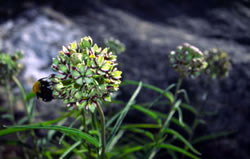
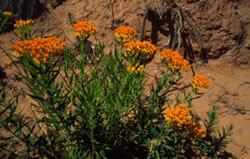
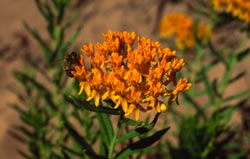
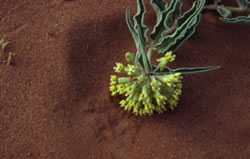
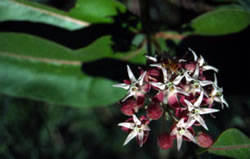
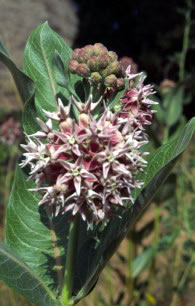
|